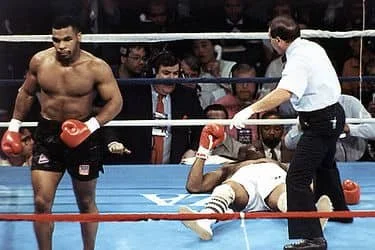Facing Iron: Michael Spinks and the Effects of Fear
Welcome to the dojo!
In this edition, we’re stepping away from ancient battlefields and into a more modern setting, under the bright lights of Atlantic City, June 27th, 1988.
Once and For All
In one corner, Mike Tyson, who at 20 years old, had become the undisputed heavyweight champion.
In the other, Michael Spinks, Olympic gold medallist, former light-heavyweight king, and undefeated lineal heavyweight champion.
Both men had never tasted defeat. But one of them walked to the ring carrying something far heavier than any belt.
Fear.
The Walk to the Ring
Michael Spinks before the Tyson Fight.
By all accounts, Spinks was terrified before the bell even rang. His $13.5 million payday wasn’t enough to drown out the storm raging inside his head. He'd struggled to sleep; instead, in his restless nights, he'd watch Tyson’s highlight reels, wanting to see patterns and weaknesses in Tyson, but instead all he saw were those brutal first-round knockouts, over and over again.
Journalists present that night described his eyes as “wide and restless.” One writer said, “He looked like a man headed for the gallows.”
Legendary trainer Emmanuel Steward remembered going to Spinks’ dressing room and finding him so rattled they “couldn’t get him to leave.” Boxing writer Royce Feour added, “I’ve never seen a fighter look as scared as Michael Spinks, and I’ve been covering boxing since 1965.”
To make matters worse, as Spinks was warming up in the dressing room, Tyson began hammering punches against the shared wall until he punched through it.
Spinks admitted later:
“I was nervous. Very, very nervous. Tyson was… Tyson.”
The Fight That Never Was
When they finally did come out to the ring, the walk would end up being longer than the fight. The first punch Tyson landed was a sledgehammer to Spinks’ body. Moments later, a short right hand to the chin ended it just 91 seconds into the first round. It was the first loss of Spinks' career.
Spinks was knocked out for the first time in his career.
Spinks had stared down adversity before. When his girlfriend was killed in a car accident in 1983, he defended his title just two months later, walking to the ring with the weight of grief on his shoulders and crying in the locker room with his infant daughter in his arms. That night, he fought through pain, fear, and heartbreak but still came through the other side victorious.
So what went wrong that night for Michael Spinks?
The Power of Fear
Spinks wasn’t just fighting Tyson. He was fighting the Tyson in his head.
That Tyson was far more powerful than even the real one.
That’s the part I find fascinating and painfully relatable.
Sports psychologist Delice Coffey describes fear as “False Evidence Appearing Real.” It’s the kind of fear that grows the longer we leave it unaddressed.
You don't have to be a world champion boxer about to face Mike Tyson to feel it. Maybe you're about to present an important idea at work, or perhaps ask someone you like out on a date.
Psychology tells us that the body can react to imagined threats with the same intensity as real ones. This is why visualisation is so practised in sports. Concentrate hard enough, and you can trigger the same physical responses just by thinking: heart racing, muscles tightening, vision narrowing.
That’s anticipatory fear, and it can rob us of our strength before the fight even begins.
The good news is that fear, if faced directly and managed, can actually sharpen your mental toughness. But if you ignore it, it grows “grander in magnitude” until it dominates your thinking and limits your performance because you give it power.
That’s the trap Spinks fell into. And it’s one we all risk falling into if we let the “fight” happen in our heads before we’ve even stepped into the arena.
And this isn't something that we acknowledge today with the advancement and understanding of the human psyche.
The famous samurai warrior Yagyu Munenori (The Life-Giving Sword) once wrote:
“The opponent is an opportunity. Fear is the only true enemy.”
He understood what we know today. The only thing to fear is fear itself, as Franklin D. Roosevelt once said.
Overcoming Fear
Here are three recommended tips and exercises to help you manage and overcome fear.
Name the fear. Try journaling and meditating on your fears to strip them of mystery. Write down what you’re afraid of; maybe even say it out loud. It loses its power when you face it head-on.
Rehearse the battle. Bruce Lee liked to visualise the challenge, including setbacks. Picture yourself staying composed no matter what the situation is. You get knocked down? No problem. Imagine yourself standing back up and getting straight back into it.
Anchor your body. Breathwork, like box breathing (inhale 4, hold 4, exhale 4, hold 4), lowers the heart rate and tells your brain, “We are safe.”
Everyone has different coping mechanisms and things that work for them that might not work for others. Perhaps these exercises might not work for you. Maybe your thing might be listening to music, for example, or going on a walk.
Fear is natural, but unmanaged fear controls you. The question isn’t “How do I get rid of this fear?” but rather “How do I walk into the ring with it and still fight my fight?”
Join us again in two weeks for more insights on how martial arts can empower your daily life.
Until then, keep fighting to flourish. Oss.
Me in my first ever amateur boxing match at 17.


